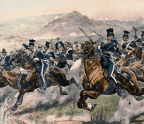News

SPACE FORCE: FIRST NEW U.S. BRANCH SINCE 1947
When President Donald Trump signed into law the 2019 National Defense Authorization Act, he in turn created the U.S. Space Force, the nation’s first new military branch since the establishment of the independent Air Force in 1947. Its mission is to “organize, train and equip space forces in order to protect U.S. and allied interests in space and to provide space capabilities to the joint force.” Among its service members’ other responsibilities is oversight of the constellation of satellites in the critical Global Positioning System. The move comes as China and Russia challenge the United States’ long-standing strategic dominance in space.
Under the act the existing Air Force Space Command was redesignated as the Space Force, and its 16,000 personnel were assigned to the new branch as “space operators.” In coming months they will be given an opportunity to voluntarily transfer into the Space Force. In an effort to keep the force specialized, such support personnel as security officers, civil engineers, cooks and chaplains will remain Air Force employees. General John W. “Jay” Raymond has been appointed the branch’s first chief of space operations and will
You’re reading a preview, subscribe to read more.
Start your free 30 days



